From 16 May to 7 June 2025
The Accademia Nazionale di San Luca presents to the public the 33 works of art donated by Gian Enzo Sperone (Turin 1939), gallerist, merchant, and collector from Turin, one of the protagonists of the international art world, who, thanks to his galleries opened over time, from Turin to Milan, from Rome to New York, has played a central role in the artistic events from the Sixties to today.
The Sperone donation is the most important legacy received by the Accademia since 1934, the year in which Baron Michele Lazzaroni bequeathed ten paintings from his collection including Judith and Holofernes by Giovan Battista Piazzetta, following the example of other illustrious donors, one of whom was Fabio Rosa, an ecclesiastic son of a painter academic who, in 1753, had donated over 180 paintings.
The donation includes 29 works by the most important figures of the Sixteenth and Seventeenth centuries, all high-quality works among which stand out the paintings by Gioacchino Assereto (Genoa 1600–1650) Lot and his daughters, 1640-1645, which belonged to the London collection of Sir Joseph Robinson, then passed to the Labia collection; by Giovanni Francesco Barbieri, known as Guercino (Cento 1591–Bologna 1666) Saint Andrew the Apostle, 1655-1656; by Vincenzo Camuccini (Rome 1771–1844) Manius Curius Dentatus rejects the gifts of the Samnites, Prince of the Accademia di San Luca from 1806 to 1810 and of Aldobrandini origin; by Ludovico Cardi, known as Cigoli (Cigoli 1559–Rome 1613) Penitent Magdalene, 1598, which was part of the Getty Museum collection in Los Angeles; by Giacomo Ceruti, known as Pitocchetto (Milan 1698–1767) Portrait of a Gentleman; by Leandro Dal Ponte, known as Bassano (Bassano del Grappa 1557–Venice 1622) Portrait of Sebastiano Fuginelli, ca. 1610; by Luca Giordano (Naples 1634–1705) Democritus, 1650-1660; by Giovanni Antonio Guardi (Vienna 1699–Venice 1760), Crassus Plunders the Temple of Jerusalem, a painting that, before entering the Sperone collection, belonged to the Milanese jurist Guido Rossi (died in 2017), also known for his refined collection of ancient and modern art; by John Jackson (Lastingham 1778–London 1831) Portrait of Antonio Canova, 1819, which entered the collection of the sculptor Francis Chantrey and was immediately exhibited at the Royal Academy, receiving wide coverage in the periodical press; by Jean Lemaire (Danmartin-en-Göele 1598?–Gaillon 1659), two extraordinary Capriccio with Triumphal Arch and Colosseum and Capriccio with Colonnade and Circular Building from the collection of Federico Zeri; by Rutilio Manetti (Siena 1571–1639) Portrait of a Gentleman (Chigi Zondadari), 1630; by Anton Raphael Mengs (Aussig 1728–Rome 1779) Portrait of Cardinal Francesco Saverio de Zelada, ca. 1773; by Giuseppe Nuvolone (Milan 1619–1703) David defeats Goliath, ca. 1680, previously in the Koelliker collection; by Bernardo Strozzi (Genoa 1581–Venice 1644) Saint Paul, 1635–1640 and the extraordinary Portrait of a Painterby Vittore Ghislandi, known as Fra Galgario (Bergamo 1655–1743) are among the pinnacles of figure painting of the period.
Two works from the early Twentieth century: Filippo de Pisis (Ferrara 1896–Milan 1956), Melodramatic Still Life, 1923, and Francesco Paolo Michetti (Tocco da Casauria 1851–Francavilla al Mare 1929), Portrait of Don Salvatore Petito - Commedia dell'arte mask, extraordinary and unsurpassed interpreter of Pulcinella and other roles

Piazza Accademia di S. Luca, 77, Rome, Italy
Opening hours
| opens - closes | last entry | |
| monday | Closed now | |
| tuesday | 15:00 - 19:00 | 18:30 |
| wednesday | 15:00 - 19:00 | 18:30 |
| thursday | 15:00 - 19:00 | 18:30 |
| friday | 15:00 - 19:00 | 18:30 |
| saturday | 10:00 - 19:00 | 18:30 |
| sunday | Closed now |
From Tuesday to Friday, from 3:00 pm to 7:00 pm (last entry at 6:00 pm) with guided tours every half hour;
Saturday from 10:00 am to 2:00 pm (last entry at 1:00 pm) and from 3:00 pm to 8:00 pm (last entry at 7:00 pm) with guided tours every half hour;
Closed on Sunday and Monday;
Free admission

From 4 April to 27 July 2025
Modern Bodies. The construction of the body in Renaissance Venice.

Galleries of the Academy of Venice, Venice

From 10 May to 31 December 2025
Madonna on a throne nursing the Child, crowned by four angels

Santa Giulia Museum, Brescia